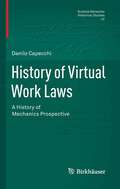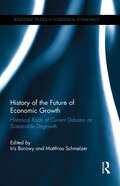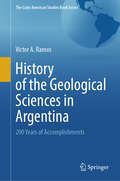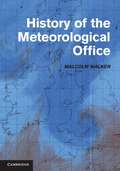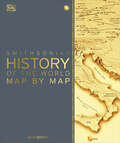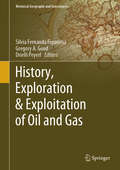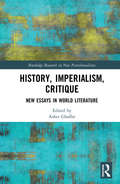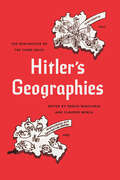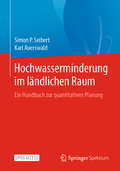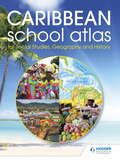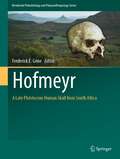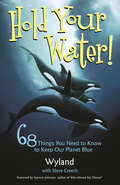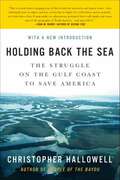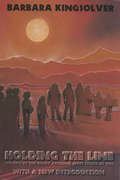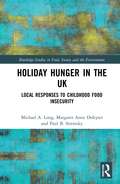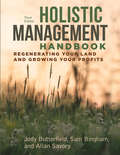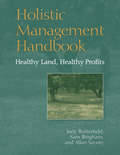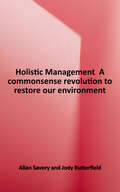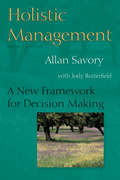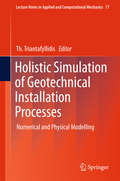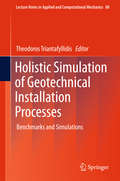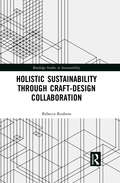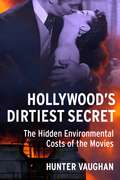- Table View
- List View
History of Virtual Work Laws
by Danilo CapecchiThe book presents a history of classical mechanics by focusing on issues of equilibrium. The historical point of view adopted here restricts attention to cases where the effectiveness of forces is assessed on the basis of the virtual motion of their points of application. For completeness, hints of the alternative approach are also referred, the Archimedean for ancient mechanics and the Newtonian for modern mechanics. The laws resulting from consideration of virtual motions are named laws of virtual work. The modern formulations of the principle of virtual work are only a particular form of them. The book begins with the first documented formulations of laws of virtual work in the IV century BC in Greece and proceeds to the end of the XIX century AD in Europe. A significant space is devoted to Arabic and Latin mechanics of Middle Ages. With the Renaissance it began to appear slightly different wordings of the laws, which were often proposed as unique principles of statics. The process reached its apex with Bernoulli and Lagrange in the XVIII century. The book ends with some chapters dealing with the discussions that took place in the French school on the role of the Lagrangian version of the law of virtual work and its applications to continuum mechanics.
History of the Climate Change on the Coromandel Coast: Ninth–Nineteenth Centuries
by S.Jeyaseela StephenThis book offers a deeper historical context to the interplay between the physical fortunes of climate and weather and the ways in which the Tamil society experienced it in the medieval age. It touches upon the rainfall, famines and droughts, storms and cyclones, earthquakes, floods and tsunamis, temperature and atmospheric pressure of the modern age, noticed by the Catholic and Protestant missionaries, European traders, travellers, the East India Company officials and servants using scientific instruments. Based on a greater variety of Tamil sources, missionary letters and reports, British and French colonial records, the monograph presents the reading of history through the lens of climate and provides a more complete picture of Tamil landscape and environment in South India from the ninth to the nineteenth century.
History of the Future of Economic Growth: Historical Roots of Current Debates on Sustainable Degrowth (Routledge Studies in Ecological Economics)
by Matthias Schmelzer Iris BorowyThe future of economic growth is one of the decisive questions of the twenty-first century. Alarmed by declining growth rates in industrialized countries, climate change, and rising socio-economic inequalities, among other challenges, more and more people demand to look for alternatives beyond growth. However, so far these current debates about sustainability, post-growth or degrowth lack a thorough historical perspective. This edited volume brings together original contributions on different aspects of the history of economic growth as a central and near-ubiquitous tenet of developmental strategies. The book addresses the origins and evolution of the growth paradigm from the seventeenth century up to the present day and also looks at sustainable development, sustainable growth, and degrowth as examples of alternative developmental models. By focusing on the mixed legacy of growth, both as a major source of expanded life expectancies and increased comfort, and as a destructive force harming personal livelihoods and threatening entire societies in the future, the editors seek to provide historical depth to the ongoing discussion on suitable principles of present and future global development. History of the Future of Economic Growth is aimed at students and academics in environmental, social, economic and international history, political science, environmental studies, and economics, as well as those interested in ongoing discussions about growth, sustainable development, degrowth, and, more generally, the future.
History of the Geological Sciences in Argentina: 200 Years of Accomplishments (The Latin American Studies Book Series)
by Victor A. RamosThe science of geology is intertwined with the growth of the field in Argentina. This book explores those dual historical developments and, as an expanded translation of Historia de la Geología Argentina: Una Crónica de Más de Dos Siglos, shares them with a global audience. Drawing on the author's extensive work throughout the country as well as documents and photographs from the archives of the National Geological Survey, General Archive of the Nation, and the universities of Buenos Aires, Córdoba, and La Plata, this book offers a once-in-a-century look at developments in the field of geology from a country-specific perspective.
History of the Meteorological Office
by J. M. WalkerMalcolm Walker tells the story of the UK's national meteorological service from its formation in 1854 with a staff of four to its present position as a scientific and technological institution of national and international importance with a staff of nearly two thousand. The Met Office has long been at the forefront of research into atmospheric science and technology and is second to none in providing weather services to the general public and a wide range of customers around the world. The history of the Met Office is therefore largely a history of the development of international weather prediction research in general. In the modern era it is also at the forefront of the modelling of climate change. This volume will be of great interest to meteorologists, atmospheric scientists and historians of science, as well as amateur meteorologists and anyone interested generally in weather prediction.
History of the Meteorological Office
by Malcolm WalkerMalcolm Walker tells the story of the UK's national meteorological service from its formation in 1854 with a staff of four to its present position as a scientific and technological institution of national and international importance with a staff of nearly two thousand. The Met Office has long been at the forefront of research into atmospheric science and technology and is second to none in providing weather services to the general public and a wide range of customers around the world. The history of the Met Office is therefore largely a history of the development of international weather prediction research in general. In the modern era it is also at the forefront of the modelling of climate change. This volume will be of great interest to meteorologists, atmospheric scientists and historians of science, as well as amateur meteorologists and anyone interested generally in weather prediction.
History of the World Map by Map (DK History Map by Map)
by DKExplore the history of the world in unprecedented detail with this ultimate guide to history throughout the ages. Maps don't just show us where to go, but also where we've been. If you're interested in finding out more about the biggest events in world history, then this book all about history of the world is perfect for you!This stunning history book for adults starts with the evolution and migration of our oldest ancestors out of Africa. You can then look up maps about the Greece and Persian War, the Mongol Conquests, Medieval Europe's trade routes, and the rise of the Ottomans. Explore maps about the colonisation of North America, the scientific revolution, Napoleon's advances, and Britain's control of India. Then uncover the history of later centuries, such as the Age of Imperialism, the American Civil War, industrialised Europe and the transformation of Japan.Journey into past like never before as you uncover:- Easy-to-read text panels for a deeper understanding of history- A total of 140 maps alongside stunning pictures and informative timelines- Storytelling maps to bring history to life- Published in association with the Smithsonian Institution in the USA.Bursting with striking illustrations and full of fascinating detail, this history book is the ultimate gift for map lovers, history enthusiasts of all ages and those who enjoy visiting museums and other historical sites, whether as a present for dad, or handy reference guide for any other history lover in your life! History of the World Map by Map aims to help you gain a strong understanding of some of the forces and movements across continents that have shaped our world!Go on guided tour through time and explore:- Prehistory 7 MYA-3000 BCE- The Ancient World 3000 BCE - 500 CE- Middle Ages 500-1450 CE- The Early Modern World 1450-1700- Revolution and Industry 1700-1850- Progress and Empire 1850-1914- The Modern World 1914-PresentAt DK, we believe in the power of discovery.So why stop there? The Map by Map series includes other titles such as History of the World Map by Map and World War II Map by Map, each detailing historical events and placing them in the context of geography. DK's luxurious Map by Map books are fantastic history gifts, packed with fascinating facts, high-quality photography, and detailed profiles and descriptions of people and events.
History, Exploration & Exploitation of Oil and Gas (Historical Geography and Geosciences)
by Silvia Fernanda Figueirôa Gregory A. Good Drielli PeyerlThis edited volume discusses scientific and technological aspects of the history of the oil and gas industry in national and international contexts. <p><p> The search for oil for industrial uses began in the nineteenth century, the first drills made in Azerbaijan and the United States. This intense search for a substance to become one of the most important energy sources was, many times, based on skill as well as luck, resulting in knowledge and the development of prospecting and exploration technologies. <p> The demand for oil improved expertise in geological science, in areas such as micropaleontology, stratigraphy or sedimentology and informed different disciplines such as geophysics. These contributions made possible not only the discovery of new oil fields but also new applications and methods of exploration. Beyond the scientific and technological aspects, an industry that grew to such considerable size also impacted the political, economic, social, cultural, environmental and diplomatic issues in history. The book approaches these changes in different scales, countries, areas, and perspectives. <p> This edited book appeals to researchers, student, practitioners in various fields from geology and geophysics to history. It is also an important resource for professionals in the oil and gas industry.
History, Imperialism, Critique: New Essays in World Literature (Routledge Research in New Postcolonialisms)
by Asher GhaffarThis book examines anti-imperialist thought in European philosophy. It features an international group of both emerging and established scholars who directly respond to Timothy Brennan’s far-reaching call to rethink intellectual histories, literary histories, and the reading habits of postcolonialism, in relation to the anti-imperialist tradition of critique. Each contributor rethinks postcolonial and world literature, Continental thought, and intellectual history in relation to anti-imperialist histories and traditions of critique, through geographically diverse analysis. This book provides a forum for the next generation of scholars to draw on and engage with the marginal yet influential work of the first generation of dissidents within postcolonial studies. It will appeal to researchers and students in the field of postcolonial studies, world literature, geography, and Continental thought.
Hitler's Geographies: The Spatialities of the Third Reich
by Claudio Minca Paolo GiaccariaLebensraum: the entitlement of "legitimate" Germans to living space. Entfernung: the expulsion of "undesirables" to create empty space for German resettlement. During his thirteen years leading Germany, Hitler developed and made use of a number of powerful geostrategical concepts such as these in order to justify his imperialist expansion, exploitation, and genocide. As his twisted manifestation of spatial theory grew in Nazi ideology, it created a new and violent relationship between people and space in Germany and beyond. With Hitler's Geographies, editors Paolo Giaccaria and Claudio Minca examine the variety of ways in which spatial theory evolved and was translated into real-world action under the Third Reich. They have gathered an outstanding collection by leading scholars, presenting key concepts and figures as well exploring the undeniable link between biopolitical power and spatial expansion and exclusion.
Hochwasserminderung im ländlichen Raum: Ein Handbuch zur quantitativen Planung
by Simon P. Seibert Karl AuerswaldDiese Open-Access-Publikation ist ein anwendungsorientiertes Lehr- und Handbuch zur Abflussminderung im ländlichen Raum. Meteorologische Extreme wie Dürren, Starkregen und Überschwemmungen häufen sich wegen des Klimawandels. Gleichzeitig steigt der Druck auf unsere Landschaft kontinuierlich, indem sie immer intensiver genutzt und effizienter erschlossen wird. Durch diese Entwicklungen ergeben sich dringende Herausforderungen für den ländlichen Hochwasserschutz und den Erhalt unserer natürlichen Ressourcen Wasser und Boden.Das Buch beschreibt Methoden für die Planung von Maßnahmen zur Abflussminderung. Es ist speziell für kleine Einzugsgebiete ( Die Autoren:Dr. Simon P. Seibert ist Ingenieurökologe und hat über die Entstehung und Modellierung von Hochwasser in München und Karlsruhe promoviert. Seit Mitte 2019 leitet er der Arbeitsgruppe Gebietshydrologie am Bayerischen Landesamt für Umwelt.Prof. Dr. Karl Auerswald lehrt am Wissenschaftszentrum Weihenstephan für Ernährung, Landnutzung und Umwelt der TU München. Seine Forschungsschwerpunkte der vergangenen 40 Jahre sind agrarökologische Prozesse, insbesondere der Wasserhaushalt von Landschaften, Böden, Pflanzen und Tieren.
Hodder Education Caribbean School Atlas
by Professor Michael MorrisseyFeel confident in full coverage of the curriculum requirements with an atlas specially created to cover Social Studies, Geography and History. - Encourage awareness of the whole Caribbean region with a 44-page Caribbean section, containing detailed maps of all independent countries and major dependent territories from The Bahamas to Trinidad, and including Belize and Guyana.- Engage students in topical issues with a world mapping section, including features on world climate, the environment and population. - Introduce a solid foundation in geographical knowledge with world facts and figures for all nations.- Secure strong geographical skills with a feature on map reading and how to use an atlas.- Ensure ease-of-use with a 4-page index showing letter-figure grid references to place names found on the maps.
Hofmeyr: A Late Pleistocene Human Skull from South Africa (Vertebrate Paleobiology and Paleoanthropology)
by Frederick E. GrineThis edited volume provides the historical and geological background, as well as the details pertaining to the morphology and morphometric assessments, of a singular human cranial specimen from the Late Pleistocene discovered in Hofmeyr, South Africa. The chapters are divided into 4 main sections. Section 1 discusses the discovery and historical context of the skull, while section 2 addresses its geological and geochronological contexts through dating and stable isotope analyses. Section 3 details the general morphological and morphometric analyses (description, 3-D reconstruction, morphological comparisons), and section 4 details the specific morphological analyses performed (inner ear, dentition, endocranial morphology and size). The volume will be of interest to professional and student paleoanthropologists interested in the later phases of human evolution.
Hold Your Water: 68 Things You Need to Know to Keep Our Planet Blue
by Wyland Steve CreechHold Your Water offers insight into the water and world around us. Taking a conversational approach to conservation, it dives into simple ways that even little old you can make a difference--all with a witty, and at times whimsical, slant on the world in which we live. The Wyland Foundation is widely lauded by politicians and scientists alike for its practical insight and positive impact on our planet. Former Vice President Al Gore praised the group, saying, "Your organization makes an invaluable contribution to the effort to promote environmental awareness."Hold Your Water is the latest in the organization's legacy of arming everyday people with straight-ahead insight and simple tips for keeping our planet blue. Written by two members of Wyland's staff, the book provides countless fascinating facts about our planet. For instance, did you realize that while two-thirds of the earth's surface is covered by water, only 3 percent of that water is safe to drink? And of that 3 percent, nearly two-thirds is locked up in polar ice caps?The book offers easy ways for people to help preserve water and other related precious resources. Divided into more than 30 sections, this compendium illustrates how everyday activities such as car washing, showering, fertilizing--even 'pet poop' cleanup--can negatively impact the environment. It then delivers more than 100 tips and tidbits that will help you protect your planet.Whether you are one of the nearly three-quarters of Americans who consider themselves environmentalists, or you just want to know more about the world in which you live, Hold Your Water is a book worth holding on to.
Holding Back the Sea: The Struggle on the Gulf Coast to Save America
by Christopher HallowellKatrina's arrival on the Gulf Coast was a long time in coming. But it was assured. Since 1965, when Hurricane Betsy struck New Orleans, breached a levee, and flooded part of the city, everyone was waiting and talking about when the Big One would strike and do even more damage. Katrina was that hurricane, predictedand imagined before she struck, but so much worse in her reality.Holding Back the Sea is about the consequences of ignoring the warning signs that nature provides and the struggle to convince the rest of the country that South Louisiana lay in the path of destruction. The signs were not subtle; there were Hurricanes Andrew in 1992, George and Mitch in 1998, and Ivan in 2004, among others. At one time or another in their journeys north, they all threatened New Orleans. Some had headed right for the city before veering to the east and west, sparing the Big Easy and reinforcing the nickname. But the Big Easy ended -- at least in reputation -- on August 29, 2005, when the Big One came ashore as Katrina.
Holding the Line: Women in the Great Arizona Mine Strike of 1983
by Barbara KingsolverHolding the Line, Barbara Kingsolver's first non-fiction book, is the story of women's lives transformed by an a signal event. Set in the small mining towns of Arizona, it is part oral history and part social criticism, exploring the process of empowerment which occurs when people work together as a community. Like Kingsolver's award-winning novels, Holding the Line is a beautifully written book grounded on the strength of its characters. Hundreds of families held the line in the 1983 strike against Phelps Dodge Copper in Arizona. After more than a year the strikers lost their union certification, but the battle permanently altered the social order in these small, predominantly Hispanic mining towns. At the time the strike began, many women said they couldn't leave the house without their husband's permission. Yet, when injunctions barred union men from picketing, their wives and daughters turned out for the daily picket lines. When the strike dragged on and men left to seek jobs elsewhere, women continued to picket, organize support, and defend their rights even when the towns were occupied by the National Guard. "Nothing can ever be the same as it was before," said Diane McCormick of the Morenci Miners Women's Auxiliary. "Look at us. At the beginning of this strike, we were just a bunch of ladies. "
Holiday Hunger in the UK: Local Responses to Childhood Food Insecurity (Routledge Studies in Food, Society and the Environment)
by Paul B. Stretesky Michael A. Long Margaret Anne DefeyterThis timely and much-needed book focuses on the phenomenon often referred to as "holiday hunger" in the United Kingdom. The book begins by outlining the history and scope of holiday hunger – the condition that occurs when a child’s household is, or will become, food insecure during the summer holidays. The decline of the UK welfare state and the rise of neoliberalism have created a situation where up to three million children in the UK face food insecurity during the summer months when there are extra financial pressures on the working poor and when free school meals are not available. This book details the level of childhood and household food insecurity in the UK and describes one of the main responses to holiday hunger – holiday clubs. These clubs are locally organised and funded and provide a place for children to go to eat nutritious meals for free during the school holidays. Highlighting the benefits of holiday clubs that often extend beyond food provision, this book also discusses the challenges that they face now and in the future. The book concludes with recommendations for food insecurity policy and the role of government in fighting holiday hunger. This book will be of great interest to students and scholars of food and nutrition security, social policy and public health.
Holistic Management Handbook, Third Edition: Regenerating Your Land and Growing Your Profits
by Jody Butterfield Allan Savory Sam BinghamHolistic management is a systems-thinking approach developed by biologist Allan Savory to restore the world's grassland soils and minimize the damaging effects of climate change and desertification on humans and the natural world. This third edition of Holistic Management Handbook: Regenerating Your Land and Growing Your Profits is the long-awaited companion volume to the classic text Holistic Management, Third Edition. Crafted under the direction of Savory's longtime collaborator Jody Butterfield, this handbook is the key to developing a comprehensive holistic land plan based on Savory's principles that will help you to restore health to your land and ensure a stable, sustainable livelihood from its bounty.This new edition, thoroughly revised, updated, and streamlined, explains the planning procedures described in Holistic Management, and offers step-by-step instructions for running a ranch or farm using a holistic management approach. Butterfield and her coauthors describe how to use the handbook in conjunction with the textbook to tailor a management plan for your unique combination of land, livestock, and finances. Their mantra is "plan, monitor, control, and replan.” Using a four-part approach, the authors walk readers through basic concepts and techniques, help them put a plan onto paper, monitor the results, and adjust the details as needed. Appendixes provide updated worksheets, checklists, planning and monitoring forms, and detailed examples of typical scenarios a user might encounter. The handbook includes a comprehensive glossary of terms.Ranchers, farmers, pastoralists, social entrepreneurs, government agencies, and NGOs working to address global environmental degradation will find this comprehensive handbook an indispensable guide to putting the holistic management concept into action with tangible results they can take to the bank.
Holistic Management Handbook: Healthy Land, Healthy Profits
by Jody Butterfield Allan Savory Sam BinghamHolistic management, as described by Allan Savory in the books Holistic Resource Management (Island Press, 1988) and the revised edition, Holistic Management (Island Press, 2001), has been practiced by thousands of people around the world to profitably restore and promote the health of their land through practices that mimic nature, and by many others who have sought a more rewarding personal or family life. Holistic Management Handbook offers a detailed explanation of the planning procedures presented in those books and gives step-by-step guidance for implementing holistic management on a ranch or farm. Holistic Management and Holistic Management Handbook are essential reading for anyone involved with land management and stewardship, and together represent an indispensable guide for individuals interested in making better decisions within their organizations or in any aspect of their personal or professional lives.
Holistic Management, Third Edition: A Commonsense Revolution to Restore Our Environment
by Allan SavoryFossil fuels and livestock grazing are often targeted as major culprits behind climate change and desertification. But Allan Savory, cofounder of the Savory Institute, begs to differ. The bigger problem, he warns, is our mismanagement of resources. Livestock grazing is not the problem; it's how we graze livestock. If we don't change the way we approach land management, irreparable harm from climate change could continue long after we replace fossil fuels with environmentally benign energy sources. Holistic management is a systems-thinking approach for managing resources developed by Savory decades ago after observing the devastation of desertification in his native Southern Rhodesia (now Zimbabwe). Properly managed livestock are key to restoring the world's grassland soils, the major sink for atmospheric carbon, and minimizing the most damaging impacts on humans and the natural world. This book updates Savory's paradigm-changing vision for reversing desertification, stemming the loss of biodiversity, and eliminating fundamental causes of human impoverishment throughout the world, and climate change. Reorganized chapters make it easier for readers to understand the framework for Holistic Management and the four key insights that underlie it. New color photographs showcase before-and-after examples of land restored by livestock. This long-anticipated new edition is written for new generations of ranchers, farmers, eco- and social entrepreneurs, and development professionals working to address global environmental and social degradation. It offers new hope that a sustainable future for humankind and the world we depend on is within reach.
Holistic Management: A New Framework for Decision Making
by Jody Butterfield Allan SavoryHolistic Management has been practiced by thousands of people around the world to profitably restore and promote the health of their land through practices that mimic nature, and by many others who have sought a more rewarding personal or family life. This book is an essential handbook for anyone involved with land management and stewardship.
Holistic Simulation of Geotechnical Installation Processes
by Th. TriantafyllidisThe book provides suitable methods for the simulations of boundary value problems of geotechnical installation processes with reliable prediction for the deformation behavior of structures in static or dynamic interaction with the soil. It summarizes the basic research of a research group from scientists dealing with constitutive relations of soils and their implementations as well as contact element formulations in FE-codes. Numerical and physical experiments are presented providing benchmarks for future developments in this field. Boundary value problems have been formulated and solved with the developed tools in order to show the effectivity of the methods. Parametric studies of geotechnical installation processes in order to identify the governing parameters for the optimization of the process are given in such a way that the findings can be recommended to practice for further use. For many design engineers in practice the assessment of the serviceability of nearby structures due to geotechnical installation processes is a very challenging task. Some hints about possible effects and their consideration are given in this book which may provide a help for such estimations which are still not possible to be given in a satisfactory manner.
Holistic Simulation of Geotechnical Installation Processes
by Theodoros TriantafyllidisThis book examines in detail the entire process involved in implementing geotechnical projects, from a well-defined initial stress and deformation state, to the completion of the installation process. The individual chapters provide the fundamental knowledge needed to effectively improve soil-structure interaction models. Further, they present the results of theoretical fundamental research on suitable constitutive models, contact formulations, and efficient numerical implementations and algorithms. Applications of fundamental research on boundary value problems are also considered in order to improve the implementation of the theoretical models developed. Subsequent chapters highlight parametric studies of the respective geotechnical installation process, as well as elementary and large-scale model tests under well-defined conditions, in order to identify the most essential parameters for optimizing the process. The book provides suitable methods for simulating boundary value problems in connection with geotechnical installation processes, offering reliable predictions for the deformation behavior of structures in static contexts or dynamic interaction with the soil.
Holistic Sustainability Through Craft-Design Collaboration (Routledge Studies in Sustainability)
by Rebecca ReubensThis book explores the intersection of craft, design and sustainability in the developing world. It argues that most sustainable design approaches and efforts fall short of implementing holistic sustainability, and in order to reach this goal, design must be underpinned by alternatives to the mainstream, technology-intensive, industrial design paradigm. Renewable materials such as bamboo, cork and hemp – which are abundantly available in the developing world – have the potential to be a viable resource base for sustainable development. Current sustainable design initiatives and approaches already recontextualize these materials using industrial techniques and technologies. However, these efforts fall short of impacting holistic sustainability and tend to focus on the ecological aspect. This book offers the development of one alternative to design for holistic sustainability, called the Rhizome Approach, which draws on existing sustainability praxis and craft. Holistic Sustainability Through Craft-Design Collaboration includes customizable tools which aim to empower designers to guide and evaluate their own designs. Through these tools, and the Rhizome Approach in general, the book aims to enable designers, and students of design, to move beyond green and sustainable design, to holistic sustainability design.
Hollywood's Dirtiest Secret: The Hidden Environmental Costs of the Movies (Film and Culture Series)
by Hunter VaughanIn an era when many businesses have come under scrutiny for their environmental impact, the film industry has for the most part escaped criticism and regulation. Its practices are more diffuse; its final product, less tangible; and Hollywood has adopted public-relations strategies that portray it as environmentally conscious. In Hollywood’s Dirtiest Secret, Hunter Vaughan offers a new history of the movies from an environmental perspective, arguing that how we make and consume films has serious ecological consequences.Bringing together environmental humanities, science communication, and social ethics, Hollywood’s Dirtiest Secret is a pathbreaking consideration of the film industry’s environmental impact that examines how our cultural prioritization of spectacle has distracted us from its material consequences and natural-resource use. Vaughan examines the environmental effects of filmmaking from Hollywood classics to the digital era, considering how popular screen media shapes and reflects our understanding of the natural world. He recounts the production histories of major blockbusters—Gone with the Wind, Singin’ in the Rain, Twister, and Avatar—situating them in the contexts of the development of the film industry, popular environmentalism, and the proliferation of digital technologies. Emphasizing the materiality of media, Vaughan interweaves details of the hidden environmental consequences of specific filmmaking practices, from water use to server farms, within a larger critical portrait of social perceptions and valuations of the natural world.
